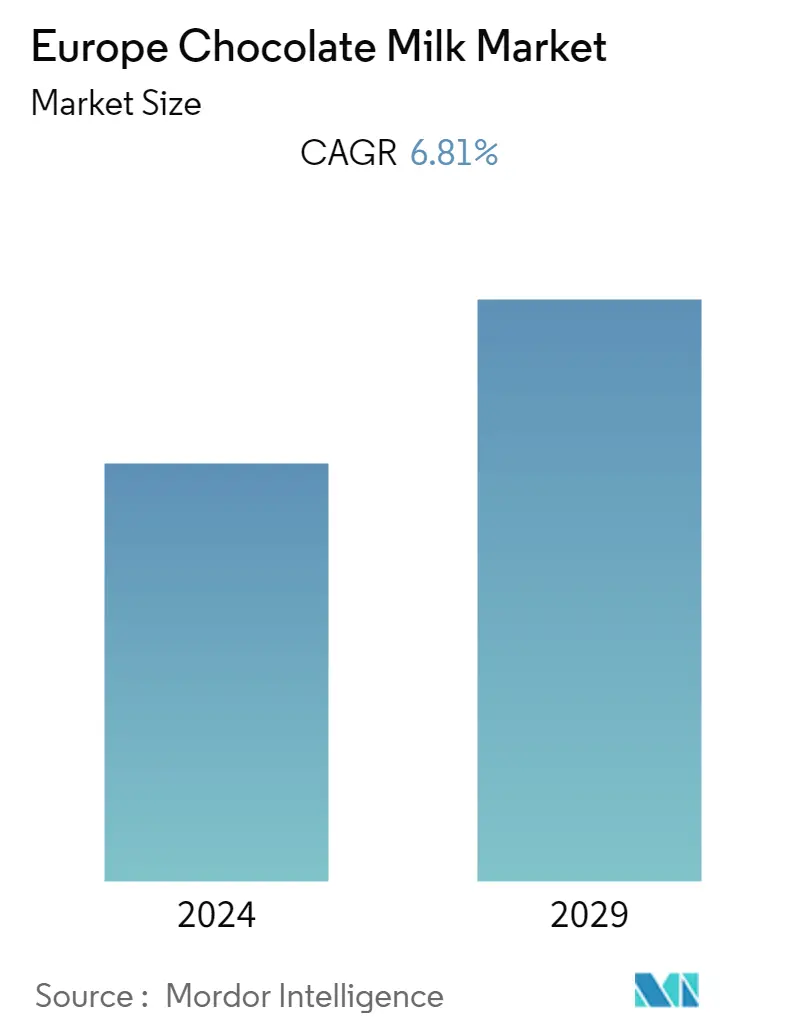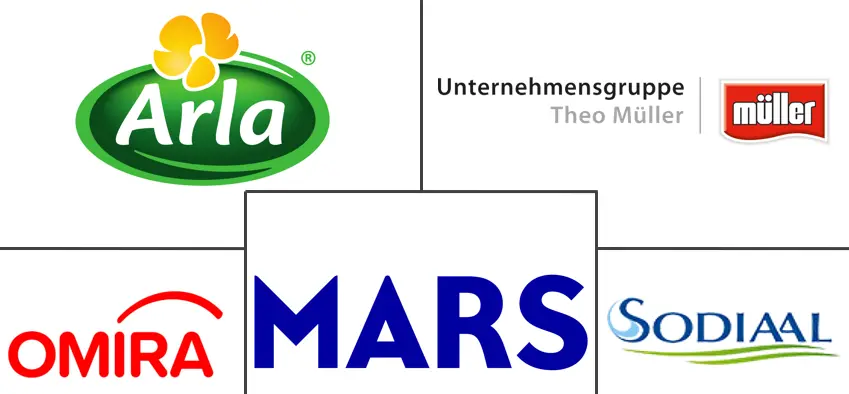Market Size of Europe Chocolate Milk Industry

| Study Period | 2019 - 2029 |
| Base Year For Estimation | 2023 |
| Forecast Data Period | 2024 - 2029 |
| Historical Data Period | 2019 - 2022 |
| CAGR | 6.81 % |
| Market Concentration | Low |
Major Players
*Disclaimer: Major Players sorted in no particular order |
Europe Chocolate Milk Market Analysis
Europe chocolate milk market is projected to grow at a CAGR of 6.81% during the forecast period (2020-2025).
- The consumer demand for convenient, natural, nutritious, and healthy on-the-go snack options is the primary attribute for the sales of chocolate milk across the region. The changing lifestyle of consumers and inclination toward a healthy lifestyle is boosting the growth of the market. Hence, chocolate milk, being the healthier and nutritional option, is witnessing increasing demand.
- Dairy-based beverages are naturally high in calcium content, and hence, are perceived as a nutritional beverage option. The health benefits of probiotic drinks, especially their ability to improve digestion and immune system, are attracting consumers across all age groups.
- Health and wellness trends have led to the inclination of consumers toward low-fat, lactose-free variants owing to rising incidences of lactose intolerance in the region, and calcium-rich variants of chocolate milk, which in turn, encourages manufacturers to innovate in the dairy-free chocolate milk category in order to gain a competitive edge over other market players.
- Low fat and fortified chocolate milk, with low sugar and added nutritional benefits, is occupying the retail market shelf, owing to the demand from consumers.
Europe Chocolate Milk Industry Segmentation
The market has been segmented by distribution channel and by geography. By distribution channel, the market studied is segmented into supermarkets/hypermarkets, convenience stores, and other distribution channels. By geography, the market studied is further segmented into the United Kingdom, Germany, France, Spain, Italy, Russia, Denmark, and the rest of Europe.
Europe Chocolate Milk Market Size Summary
The European chocolate milk market is experiencing significant growth, driven by consumer demand for convenient and nutritious on-the-go snack options. This trend is largely attributed to changing lifestyles and a growing inclination towards healthier living. Chocolate milk, being a dairy-based beverage rich in calcium, is perceived as a nutritional choice, appealing to health-conscious consumers. The market is further bolstered by the popularity of probiotic drinks, which are known for their digestive and immune system benefits. As consumers increasingly seek low-fat and lactose-free variants due to rising lactose intolerance, manufacturers are innovating in the dairy-free chocolate milk category to maintain a competitive edge. The demand for fortified chocolate milk with low sugar and added nutritional benefits is also on the rise, reflecting a broader shift towards organic and sugar-free options as consumers become more aware of the disadvantages of artificial ingredients.
The market landscape is highly competitive, with both regional and global players vying for market share. Companies like Arla Foods, Unternehmensgruppe Theo Müller, and Mars, Incorporated are leading the charge, investing in new product developments and innovative offerings to attract consumers. The United Kingdom stands out as a key market, driven by new product launches and favorable regulatory changes, such as the VAT exemption on chocolate milk shakes. To capture a larger audience, companies are leveraging social media and online distribution channels, and forming partnerships with sports and entertainment industries to promote healthy milk-drinking habits, particularly among children. This dynamic environment is fostering continuous innovation and strategic collaborations, ensuring sustained growth in the European chocolate milk market.
Europe Chocolate Milk Market Size - Table of Contents
-
1. MARKET DYNAMICS
-
1.1 Market Drivers
-
1.2 Market Restraints
-
1.3 Porter's Five Forces Analysis
-
1.3.1 Threat of New Entrants
-
1.3.2 Bargaining Power of Buyers/Consumers
-
1.3.3 Bargaining Power of Suppliers
-
1.3.4 Threat of Substitute Products
-
1.3.5 Intensity of Competitive Rivalry
-
-
-
2. MARKET SEGMENTATION
-
2.1 By Distribution Channel
-
2.1.1 Supermarkets/Hypermarkets
-
2.1.2 Convenience Stores
-
2.1.3 Other Distribution Channels
-
-
2.2 By Geography
-
2.2.1 United Kingdom
-
2.2.2 Germany
-
2.2.3 France
-
2.2.4 Italy
-
2.2.5 Spain
-
2.2.6 Russia
-
2.2.7 Denmark
-
2.2.8 Rest of Europe
-
-
Europe Chocolate Milk Market Size FAQs
What is the current Europe Chocolate Milk Market size?
The Europe Chocolate Milk Market is projected to register a CAGR of 6.81% during the forecast period (2024-2029)
Who are the key players in Europe Chocolate Milk Market?
Arla Foods, OMIRA GmbH, Mars Inc., Unternehmensgruppe Theo Müller and Groupe Sodiaal are the major companies operating in the Europe Chocolate Milk Market.

